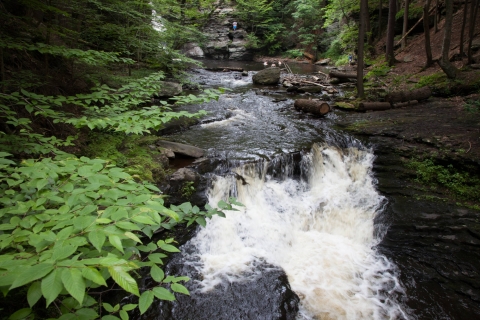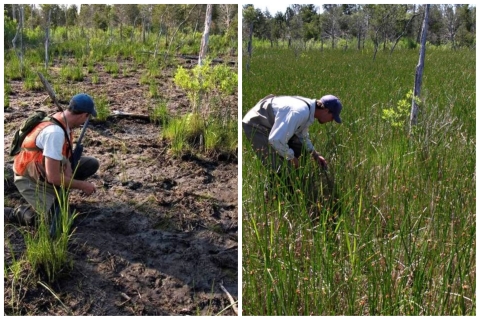When you’re a government agency brimming with scientists, it can be easy to get bogged down in the lingo, and the acronyms — don’t get us started on acronyms…
There are three tricky terms that form the foundation of so much of the work we do: landscape conservation, fish passage fish passage
Fish passage is the ability of fish or other aquatic species to move freely throughout their life to find food, reproduce, and complete their natural migration cycles. Millions of barriers to fish passage across the country are fragmenting habitat and leading to species declines. The U.S. Fish and Wildlife Service's National Fish Passage Program is working to reconnect watersheds to benefit both wildlife and people.
Learn more about fish passage and ecosystem restoration. Don’t hit the snooze button; let’s break these down, or “unpack” them — that’s popular jargon these days, right?
Landscape conservation
Approaching a project, it may seem addressing conservation needs is relatively simple — replace the pipe under that road; put sand back on a beach there; plug that oil well over there — but looks can be deceiving.
As often as we can, we study the bigger picture, using the landscape conservation approach. There may be dozens of small to large projects to move on, but the work isn’t done all willy-nilly. Landscape conservation zooms out and looks at a big swath of land, or an entire river system, to look for connections. Say, for instance, we want to help a species like American shad by removing obstacles on its path to breeding grounds. We need to see the fish’s journey as the sum of its parts: ocean, bay, salt marsh salt marsh
Salt marshes are found in tidal areas near the coast, where freshwater mixes with saltwater.
Learn more about salt marsh and river — the entire “landscape” (and yes, that includes water, too).
Typically, when we're restoring passage for fish like shad, which need to move between a river and the ocean, we don’t look at removing a dam at the very “top” of the river first; we work our way from the bottom up. If you take out a barrier at the headwaters, but there are seven more below it, you haven’t really given fish a chance to move anywhere. And if you get all of the barriers removed, but the salt marsh that serves as their nursery where the river meets the sea is degraded and receding, you haven’t solved the whole problem.
By zooming out, we can prioritize work to address the greatest needs — and have the biggest impacts — first. Landscape conservation manages and protects interconnected lands to restore the entire natural area and looks for opportunities to bring disjointed ecosystems back together, all for the benefit of fish, wildlife and people.
Fish passage
The Service and our partners can be thought of as conservation Gandalfs — ensuring safe passage to our fishy friends. Then again, the dams thwarting fish movement upriver also give off Gandalf vibes — “You shall not pass!” Oh, well ... moving on.
Fish passage is a concise way to describe the comings and goings of fishes in a waterway. Efforts to improve fish passage address common issues facing aquatic species. Dams, culverts and even dirty water can prevent fish and other animals from traveling up and down a stream, creek, river or bay. We work with partners to remove dams, replace culverts and clean up water.
Sometimes, when a dam can’t be removed, we build a fish ladder, which certainly sounds like a weird contraption for an animal with no arms and legs. Fish ladders create a series of pools, like steps, that fish can swim into, from one to the next, around or over the barrier and back to the water source.
Many culverts are outdated, crumbling and unfit for fish passage. Replacing them with structures that allow the stream to flow naturally offers fish like the American shad a much easier experience passing through. Often, erosion causes the ends of a culvert to become "perched" above the water's surface. In low-water conditions, it can act like a tiny dam, even if it is just a short step — you try jumping to a ledge that’s just above your head!
Water quality affects everything that relies on a water source. From stormwater runoff to trash, and even extra heat from climate change climate change
Climate change includes both global warming driven by human-induced emissions of greenhouse gases and the resulting large-scale shifts in weather patterns. Though there have been previous periods of climatic change, since the mid-20th century humans have had an unprecedented impact on Earth's climate system and caused change on a global scale.
Learn more about climate change , many types of pollution affect rivers. And clearly, a polluted river doesn't serve aquatic or human communities. By removing barriers and restoring the banks of the rivers, we can improve the quality of the water and provide fish safe passage.
Ecosystem restoration
Once we understand the barriers, and how the habitats within a landscape work together, we can begin ecosystem restoration.
Ecosystem restoration can involve adding to the landscape or taking away. The aim is to renew and restore. Whether adding native plants to a riverbank to help cleanse the water, reintroducing grasses to thinning and degrading salt marshes to increase their resilience, taking out barriers to allow for fish passage, or putting sand back on beaches destroyed by storms to increase critical habitat for endangered species and protect local communities, no effort is too small — and together, now, that’s ecosystem restoration!
Even removing invasive plants like the common reed (Phragmites australis) from salt marsh is part of these restoration projects. Invasive species out-compete native ones and can take over a natural space, reducing the diversity of plants and animals. Salt marsh is a crucial habitat that supports a variety of wildlife (remember, it serves as an American shad nursery) and protects people from the damaging effects of sea-level rise and storm surge caused by climate change.
Our Northeast Region received more than $900,000 in Bipartisan Infrastructure Law Bipartisan Infrastructure Law
The Bipartisan Infrastructure Law (BIL) is a once-in-a-generation investment in the nation’s infrastructure and economic competitiveness. We were directly appropriated $455 million over five years in BIL funds for programs related to the President’s America the Beautiful initiative.
Learn more about Bipartisan Infrastructure Law funds for 2023 Ecosystem Restoration projects. Two of these projects will create and support a more resilient coast by restoring 142 acres of salt marsh, through replanting vegetation and filling in areas washed away by storm surge.
Helping at home
While it may be hard to help with landscape conservation and fish passage in your community (well, you can refrain from stacking rocks in streams, creeks and rivers to form little dams), you can practice ecosystem restoration by planting a pollinator garden or creating a green space. You may even find opportunities through your local botanic garden to pluck invasive plants from the ground with your own hands, a quite-satisfying experience.
If you’d like to know more about what we’re doing right now in all three of these areas, check out these project examples:
Landscape conservation project
In 2022, the Pennsylvania Fish and Boat Commission submitted a proposal to remove the Spring Garden Dam on Neshaminy Creek in Bucks County, Pennsylvania. This active project considers an entire landscape, addressing issues on a high-priority stream that directly impact the watershed. This dam removal will restore passage for migratory fish like the American shad. Funded in part by the Bipartisan Infrastructure Law (BIL), the removal will also improve water-based recreation, re-establish aquatic connectivity, and eliminate a public-safety hazard by eliminating the nine-foot-high, 255-foot-long concrete dam in Tyler State Park.
Fish passage project
In the summer of 2023, the High Street Dam was removed in the Taunton River watershed in Massachusetts. This one dam removal reconnected 10 river miles in a 562- square- mile watershed that stretches all the way to Rhode Island’s Narragansett Bay and the Atlantic Ocean. Not only does this project open waters to American shad, blueback herring, and American eel, it also connects 354 acres of spawning habitat for alewife. This project, funded in part by the BIL, removes a hazard to human safety and will likely create positive economic impacts for commercial and recreational fishing.
Ecosystem restoration project
In Assateague, Virginia, 82 acres of tidal marsh will be restored as part of the Ecosystem Restoration Framework instituted through BIL funding. This large-scale project will help sustain productive fisheries and strengthen resilience within the ecosystem, as well as reduce climate change impacts on nearby communities. By addressing potential flood risks and habitat degradation, projects like this one have lasting benefits to people and wildlife and are essential to ensuring the safety and security of coastal communities.






